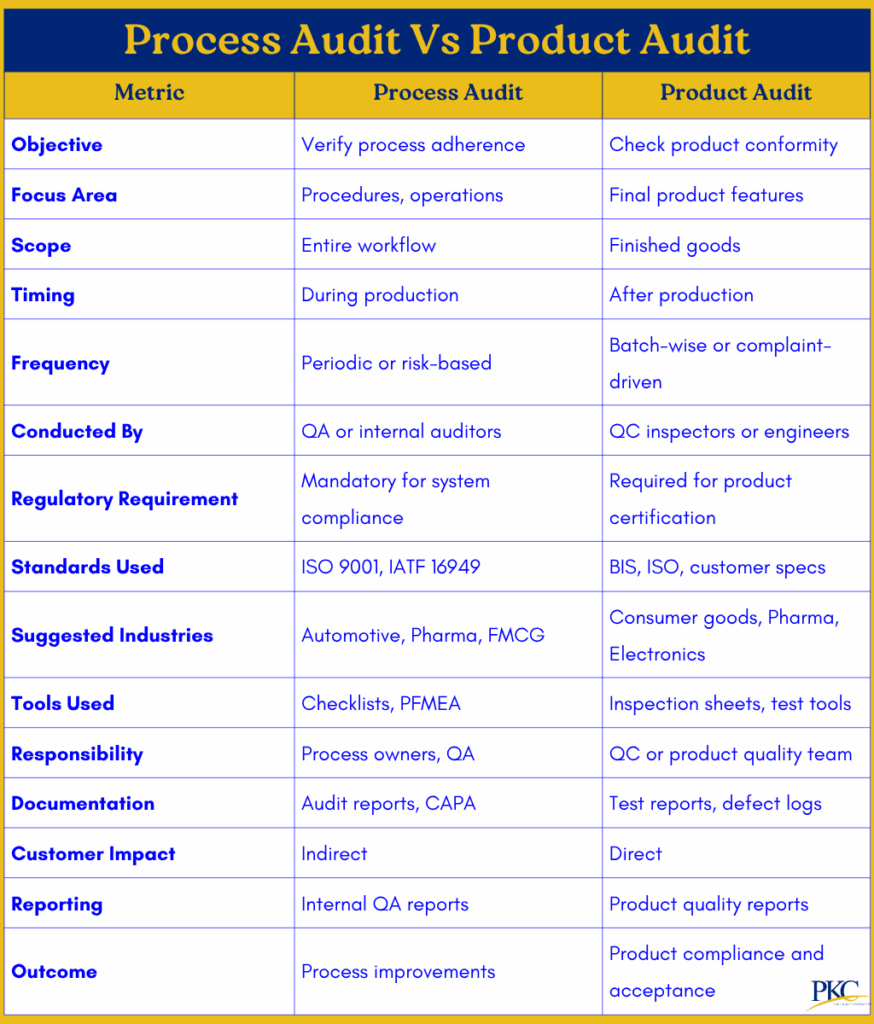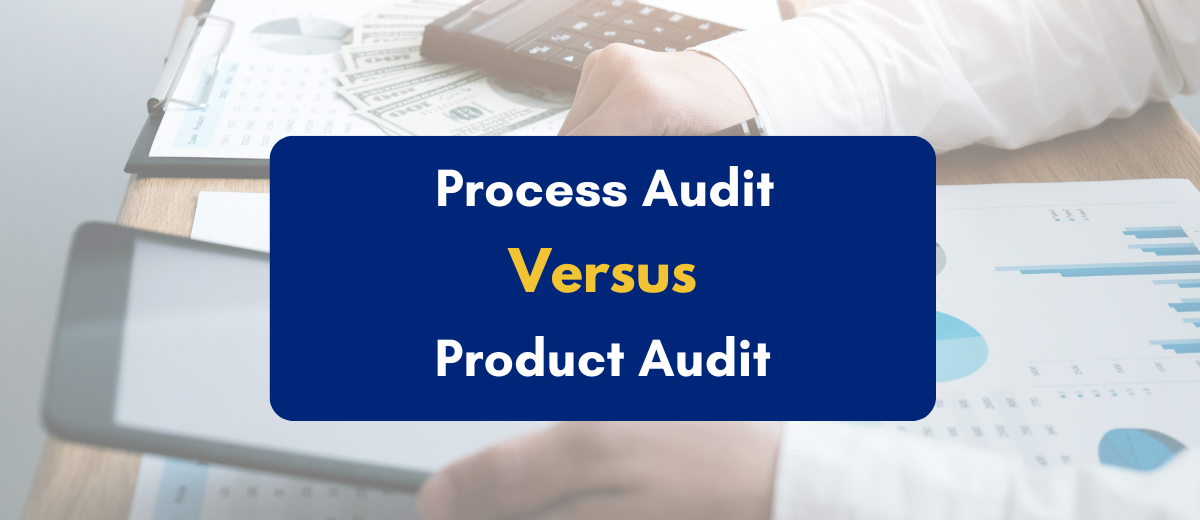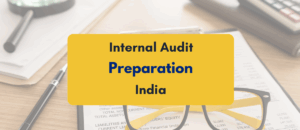Understanding the difference between process audit vs product audit India is the first step to protecting your product quality and passing compliance inspections.
Delve with us deeper as we break down both audits in simple language using examples from different industries.

14+ Major Differences Between Process Audit and Product
Let’s take a look at the major differences between process and product audits with examples compiled under various metrics:
What is Process Audit Vs Product Audit?
Process Audit: Examines how activities are carried out within a system. It checks if procedures, methods, and controls are properly followed to convert inputs into outputs.
Example: Auditing the procurement process in a manufacturing company to see if suppliers are selected and evaluated as per SOPs.
Product Audit: Checks the final output – a product or deliverable. It verifies if the finished item meets technical specifications, regulatory requirements, or customer expectations.
Example: Inspecting a lot of LED bulbs before dispatch to ensure brightness, voltage tolerance, and packaging meet standards.
Difference is Objectives
Process Audit: To ensure processes are effective, efficient, consistent, compliant, and capable of producing the desired results reliably. It aims to prevent defects by improving the system.
Product Audit: To verify that a specific finished product or batch conforms to defined specifications, drawings, standards, or contractual requirements. It aims to detect defects in the output.
Focus Areas of Product Vs Process Audits
Process Audit: The activities, resources, methods, controls, inputs, and environment involved in producing the output. (e.g., adherence to work instructions, machine settings, operator training, calibration status).
Product Audit: The physical and functional characteristics of the final item itself. (e.g., dimensions, weight, appearance, performance, safety features, packaging, labeling).
Scope Variations
Process Audit: Covers one or more specific processes or sub-processes within an organization (e.g., procurement, welding, software testing, customer complaint handling, etc. ).
Product Audit: Covers a specific finished product, batch, or service output (e.g., A specific software release version, completed insurance policy document, etc. ).
Timing of Process Audit Vs Product Audit
Process Audit: Conducted during the execution of the process or while the system is operational. It can be done at any stage.
Product Audit: Conducted after the product or service has been completed, often just before shipment or release to the customer.
Difference in Frequency
Process Audit: Usually performed periodically (e.g., quarterly, annually) based on a schedule, risk assessment, or triggered by changes or issues. Focuses on the ongoing health of the system.
Product Audit: Often performed per batch, per shift, per project milestone, or at defined intervals (e.g., daily, weekly). Can also be triggered by customer complaints or specific sampling plans. Focuses on specific outputs.
Who Conducts the Audits?
Process Audit: Conducted by trained internal auditors, second-party (customers), or third-party bodies (like ISO certification agencies).
Product Audit: Primarily conducted by internal Quality Control (QC) personnel, inspectors, or test lab staff. Customer representatives or third-party labs may also conduct product audits/verification.
Standards & Regulatory Requirement
Process Audit: They are often required indirectly as part of compliance with standards such as quality management system (QMS) certifications or customer-specific requirements.
Examples:
- ISO 9001: Often needed for tenders or client compliance
- IATF 16949: Required by automotive industry contracts
- GMP Audits (Schedule M): Mandatory for pharma manufacturing compliance
Product Audit: These are direct regulatory requirements, where compliance is verified through product testing and certification. Examples:
- BIS Certification: Mandatory for products like appliances and cement, ensuring standard compliance
- FSSAI Testing: Required for food safety and regulation
- AIS Certification: Needed for auto parts, meeting industry standards
- CDSCO Testing: Ensures drugs meet regulatory norms before market release
Suggested Industries
Process Audit: Applies across manufacturing, IT, healthcare, logistics, and construction. Any sector where process consistency matters.
Product Audit: More common in manufacturing sectors – automotive, electronics, pharma, FMCG – where the physical output is evaluated.
Tools Used
Process Audit:
- Tools & Techniques: Checklists, flowcharts, turtle diagrams
- Methods: Interviews, observation, data analysis (SPC, trends)
- Records Review: Calibration, training, other compliance records
Product Audit:
- Measurement Tools:Calipers, micrometers, gauges
- Testing Equipment: Tensile testers, environmental chambers
- Analysis & Inspection: Lab tests (chemical/micro), visual aids, performance rigs
- Documentation Review: Test reports, certificates
Responsibility
Process Audit: Responsibility lies with Management, Quality Assurance (QA) department, Process Owners, and Internal Audit teams.
Product Audit: Responsibility lies with the Quality Control (QC) department, Inspection personnel, Testing Laboratories, and the Final Release Authority.
Documentation Requirements
Process Audit: They focus on system level evidence including:
- Audit plans and checklists
- NCRs (Non-Conformance Reports)
- CAPA documentation
- Follow-up records
Product Audit: Here the focus is on product-specific evidence such as:
- Inspection/test plans
- Raw data and test reports
- Certificates of analysis
- Tracking logs
- Conformity/non-conformity records
- Product release/hold records (e.g., MRR)
- Disposition records (rework, scrap)
Customer Impact
Process Audit: Has an indirect but long-term impact. It builds customer confidence in the supplier’s capability to consistently deliver conforming products, reduces the risk of defects, improves reliability, and enhances overall quality perception.
Example: Improved assembly line process reduces warranty claims.
Product Audit: Has a direct and immediate impact. It determines if this specific product shipped to the customer meets requirements. Failure leads directly to customer complaints, returns, recalls, safety issues, loss of trust, and potential penalties.
Example: A faulty microwave shipped without proper product audit may lead to recall.
Reporting
Process Audit: Reports focus on process effectiveness, compliance, and systemic weaknesses.
Findings are typically non-conformities against the QMS or process standards. Recommendations target process improvements.
Product Audit: Reports focus on product conformity. Findings state whether the specific product/batch passed or failed against its specifications.
Details include the type, quantity, and severity of defects found. Actions focus on the specific non-conforming product (accept, reject, rework, scrap).
Outcome
Process Audit:
Outcomes:
Identification of systemic weaknesses
Opportunities for process improvement
Enhanced efficiency and reduced variation
Strengthened controls and sustained process capability
Corrective Actions:
- Primarily preventive in nature
- Focused on fixing the system to prevent recurrence of issues
Product Audit:
Outcomes: Binary result for the audited product or batch:
- Accepted: Meets requirements and is ready for release
- Rejected: Does not meet requirements
Corrective Actions:
- Primarily reactive in nature
- Address specific non-conforming products (e.g., rework, scrap, sort)
- May lead to further investigation to determine root cause if systemic issues are identified, may trigger a process audit
How Can PKC Help With Product & Process Audits?
✅Zero compliance penalties through proactive risk identification
✅Expert regulatory knowledge across Indian laws and standards
✅Real-time audit updates with transparent management communication
✅Comprehensive process documentation identifies all operational gaps
✅Quick turnaround delivery from days to weeks maximum
✅Quality standard compliance ensures manufacturing process control
✅Financial and operational dual-expertise in single engagement
✅Risk mitigation strategies with practical implementation solutions
✅Process improvement initiatives beyond basic compliance requirements
Get in Touch With Our Experts Today!
Frequently Asked Questions
- How does a process audit differ from a product audit?
A process audit examines procedures and workflows, while a product audit checks the finished product. Both work together to guarantee total quality.
- Can one team handle both process and product audits?
Sometimes one team can handle both, but separating them improves impartiality. Third-party certification bodies are often used for product audits.
- Does ISO 9001 require process and product audits?
Yes, ISO 9001:2015 expects both to be part of your quality management system. This supports ongoing improvement and risk management.
- Is it easier to pass a product audit if you have a strong process audit program?
Definitely. A strong process audit reduces mistakes, so your finished product is more likely to pass.
- Who should attend both types of audits?
Usually, quality managers, process engineers, and sometimes the operations team. Having them involved guarantees better corrective action plans.

 Expert verified
Expert verified 

